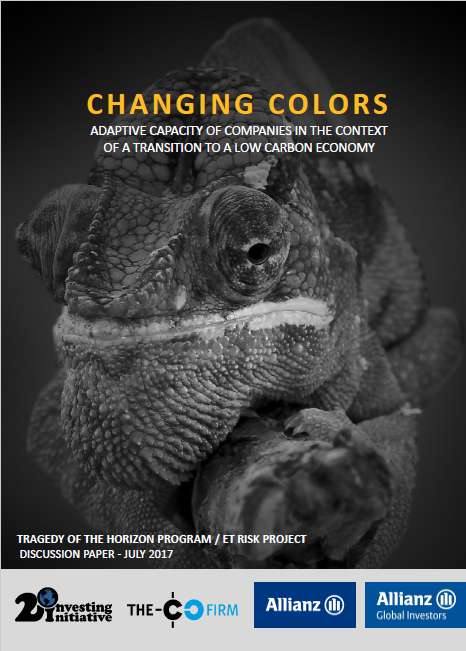Changing colors - adaptive capacity of companies in the context of a transition to a low carbon economy
EXECUTIVE SUMMARY
This paper seeks to explore the question of adaptive capacity of companies to financial risks that may arise in the context of the transition to a low-carbon economy.
A growing body of research and analysis highlights potential risks associated with the transition to a low- carbon economy, related to a combination of policy, market, legal, and reputational drivers (FSB, 2016). The (European Systemic Risk Board, 2016) suggests that these risks may be particularly material under a too late, too sudden scenario, where the transition to a low-carbon economy is triggered in a non-linear, disruptive fashion, thus reducing the ability for companies and markets to adapt. While this scenario may be the most ‘disruptive’, existing research on transition risk has generally not sought to quantify how adaptive capacity can protect companies from this risk.
While financial analyst models provide results in cash flows and / or risk indicators (e.g. value at risk), they also implicitly include assumptions about adaptive capacity.
Revenues or profits that grow 100% in line with GDP imply an adaptive capacity assumption (elasticity) of 1 to GDP1. Similarly, 100% alignment with sector growth suggest an adaptive capacity of 1 to the sector. Inversely, where revenues or profits grow at 150% the rate of GDP, the model results assume that for every $1 of growth in the economy, the company grows by $1.5. In simple terms: Adaptive capacity can thus mathematically be expressed as revenue or profits2 / Sector (reflecting a company’s internal ability to adapt) or / GDP growth (reflecting external drivers).
The nature of adaptive capacity is driven by the nature of the external shock / constraint to which companies have to adapt and the internal capabilities to respond to these constraints:
- External constraints and shocks determine the need for adaptive capacity. The extent to which they pose a challenge is determined by the speed and scale, as well as the idiosyncrasy of the change, and the extent to which the impact represents a secular decline versus usual business cycle dynamics. Thus, external shocks or constraints that are linked to business-cycle dynamics or ‘one-off’ shocks require resilience. External shocks in turn with some form of permanence require adaptive capacity. The focus of this paper is on the second.
- Internal dynamic / strategic capabilities determine the quality of the response, driven in particular by questions around governance and the ‘dynamism’ of the organization. This dynamism is in turn constrained by the assets of the company, notably the capital lock-in, the strength of the balance sheet, the product diversity, and other socio-political factors.
Long-term adaptive capacity in particular in response to transition risks associated with a too late, too sudden scenario, is usually not explicitly modelled by analysts.
While there are legitimate reasons for this, notably the lack of demand for long-term risk assessment by clients and the uncertainty of long-term risks, this poses a challenge to understanding transition risks. Potential solutions to overcome this gap include stress-testing worst case scenarios, probability- weighted response scenarios, modelling based on historical role models, bottom-up assessments, and / or adjustments of risk premium.
To download the full report, please click here.

